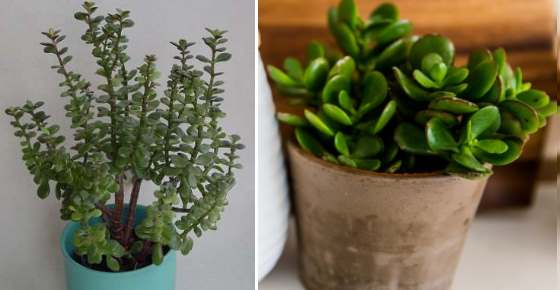Jade plants are popular houseplants and can grow in a variety of indoor settings. They are simple to care for. The crassula ovata variety, often known as the money plant, dollar plant, money tree, and lucky plant, is one of the most common types of jade plants. According to Feng Shui, this jade plant is not just attractive, but it also attracts prosperity and luck into a dwelling. Jade plants come in a variety of shapes and sizes, and they are adaptable to growing in less than ideal circumstances.
The genus Crassula and family Crassulaceae include jade plants, which are a kind of succulent plant. Several species of jade plants and trees are popular because they are linked to money and success. Crassula Ovata cultivars are frequently seen in workplaces and residences. They’re also popular presents at weddings and for starting new businesses, because some people believe they’re lucky plants that bring good luck.
Jade plants are simple to take care of and may even flourish in low-light situations. All you have to do to care for a jade plant is give it occasional water, trim off the branches when needed, and keep it out of the sun. The money plant will provide you with gorgeous green lush foliage, which can dress up any space. You’ll learn about numerous Jade Plants (Crassula varietal) types, as well as how to care for them, in this article.
About Jade Plants
There are roughly 200 species of jade plants (Crassula) native to South Africa. The tear-shaped, oval-shaped, or wedge-shaped green leaves give them their name. Red blushing around the edges of the leaves is common. Jade trees have thick stem and smooth glossy green or yellowish leaves in hot tropical environments. These succulents may grow up to 8 feet (2.5 meters) tall in the wild and have a tree-like appearance.
Jade plants and trees are grown as indoor plants for their decorative appeal. Jade plants are small and easy to care for when grown in pots. Branches like small trees and coin-shaped leaves characterize some jades (Crassula). Low-growing jade with pencil-shaped or spiky leaves is a different kind that grows slowly.
Jade succulent leaves may have crimson borders around the margins, depending on how much sunlight they receive. Yellowish-green leaves are seen in some jade cultivars, while bluish-green leaves are found in others.
Jade plants may also bloom under the right conditions. The evenings should be chilly and the days bright for your jade plants to see flowers bloom. A jade plant also requires dry conditions to bloom. During the winter, this is a common occurrence. You can attempt to recreate these circumstances at home if you want your jade plant to bloom with pinkish-white star-shaped blooms in the spring.
Types of Jade Plants
Let’s take a closer look at the different types of jade plants that may be grown indoors. Jade plant varieties include the following:
Money Plant (Crassula Ovata)
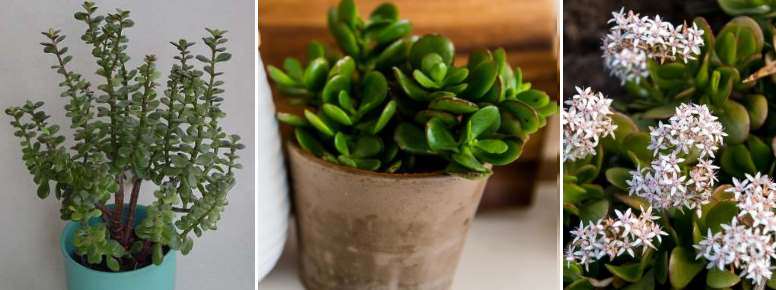
Crassula ovata, or money plant, is a succulent that can be cultivated both inside and out. It has pale blooms. Because of its tree-like appearance, some individuals refer to this jade plant as the money tree. The Pachira aquatica, on the other hand, is the real money tree plant.
The succulent leaves of the money plant are jade-green obovate (tear-shaped) and grow to a length of between 1.1 and 3.5 inches (3–9 cm). The amount of leaves on the money plant might make it seem like a lush indoor shrub. A bright location away from direct sunlight is the best place in your home for a money plant.
According to Feng Shui adherents, this lucky plant should be placed in a home or workplace’s “money region.” Money plants produce tiny white-pink stars that bloom throughout the winter and are shaped like a star.
Crassula Ovata ‘Lemon & Lime’
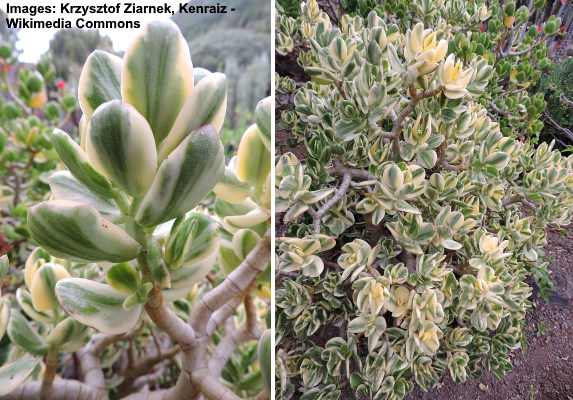
The Crassula ovata cultivar ‘Lemon & Lime’ has variegated leaves, which are a gorgeous addition to your garden. The leaves of this bushy succulent are lime green and yellowish stripes that have been extended oval. When growing in the sun, the variegated leaves may grow up to 2 inches (5 cm) long and acquire faint reddish margins. The 4-foot-tall (1.2 m) Lemon & Lime jade bush may be trimmed to maintain its size and resemble a shrub.
Crassula Ovata ‘Skinny Fingers’

The succulent leaves of the cultivar known as the “Skinny Fingers” resemble long thin fingers, as do those of the cultivar known as the “Gollum” (left) and the “Hobbit” (right). These jade-colored leaves have crimson tips and may grow up to 2″ (5 cm) long.
This Crassula cultivar has a shrubby appearance due to its short branches and many leaves. This isn’t a little jade plant; it’s neither towering nor growing excessively. You might see little star-shaped white or pink blooms in the winter if you expect it to grow up to 3 feet (90 cm). The jade ‘Gollum’ and jade ‘Hobbit’ cultivars are comparable to the Skinny Fingers cultivar.
Golden Jade Tree (Crassula Ovata ‘Hummel’s Sunset’)

The jade cultivar ‘Hummel’s Sunset’ has golden yellow and green leaves, and it is a winner of awards. The foliage is also known as the ‘Golden jade tree’ because of its gorgeous hues. During the colder months, they create fleshy leaves with tear-shaped and bright lime green and yellow hues with crimson borders. The typically golden-yellow leaves turn a mustard color of yellow in the winter due to the lack of sunlight.
Miniature Jade Plant (Crassula Ovata ‘Minima’)

The Crassula ovata cultivar ‘Miniima’ is a tiny jade plant with little green and crimson-pointed leaves. This variety, being a dwarf jade tree, is limited to 2.5 feet (75 cm) in height and a 20-foot (50-cm) spread. The leaves on this tiny jade plant aren’t as thick as those of typical jade plants.
The succulent shrub has a tree-like appearance as a result of this. This jade plant will not make you richer, but it will improve the aesthetic of any space.
Dwarf Jade Plant (Crassula Ovata ‘Crosby’s Compact’)
Rather than a jade tree, the jade cultivar known as Crosby’s Compact resembles a tiny succulent shrub. The plant has a pleasant cosy appearance with light green and crimson obovate (tear-shaped) leaves covering each branch. This dwarf jade has tiny leaves that are an inch (2.5 cm) long, as opposed to the usual jade plants with bigger leaves.
Newly developing leaves are normally totally crimson, which is an fascinating distinguishing characteristic of this little jade plant.
Pink Jade Plant

This jade plant has pinkish stems and flowers, and is known as the Pink Beauty cultivar. This cultivar has pink-colored stems, unlike most other jade plants with brown stems. On the colorful stems, the stems generate obovate leaves that are thin. With a mature plant growing up to 5 feet (1.5 meters) tall, this pink jade species is one of the larger types.
This pink jade might reward you with star-shaped pink blooms in the winter if you’re lucky enough. On dark winter days, these floral clusters emit a lovely aroma that aid to brighten up rooms.
Gollum Jade (Crassula Ovata ‘Gollum’)
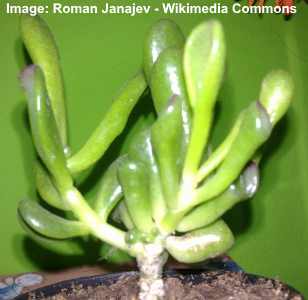
The tubular shape of the jade-green leaves is referred to as the ‘Finger jade,’ ‘Hobbit’s pipe jade,’ and ‘Trumpet jade.’ Succulent leaves cluster around the thick brown branches, which tend to grow at the top. The variegated Trumpet Jade is another lovely variation of the Gollum jade.
The tubular leaves of this brilliantly-colored money tree are yellow and green with a reddish tint. The ‘Gollum,’ or jade plant, is a wonderful kind of plant for bonsai enthusiasts to grow into a jade bonsai tree.
Jade Plant ‘Botany Bay’

In colder or dry weather, the crimson tips of the jade cultivar leaves are more visible, therefore many people associate jade plants with fortune. The shrub-like growing habits of the slow-growing jade money plant allow it to be grown into a variety of forms. The light jade-green leaves with red borders are one of the appealing characteristics of this jade species. In the winter or in dry weather, the red color can become more noticeable.
‘Harbour Lights’
The cultivar ‘Harbour Lights’ of the Crassula ovata has a similar appearance to the ‘Botany Bay’ plant. Little leaves with a jade-green and red hue grow on the long woody stems. In winter, the ‘Harbour Lights’ cultivar produces gorgeous starry pink blooms, as do all varieties of jade plants.
Crassula Ovata ‘Hobbit’
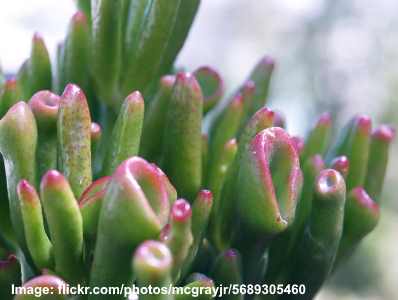
The Crassula ovata ‘Hobbit,’ sometimes known as the Crassula argentea ‘Hobbit,’ has a distinctive tubular form to its leaves, which have crimson ends. The tubular leaves have crimson tips and open out at the conclusion, returning to their original position. It’s critical to trim the jade plant correctly in order to create a jade bonsai plant. To attract good luck and happiness, this might be formed into unusual and eastern designs.
Other Crassula Types
The genus Crassula includes money trees like jade plants. Let’s take a look at some additional jade species that may brighten up any dwelling or office.
Silver Jade Plant (Crassula Arborescens)

The silver jade plant, sometimes known as the Chinese jade, silver dollar plant, and even money plant, blossoms in winter with white to pink flowers. The grayish-silver leaves that some describe as looking like a dollar gave this succulent its name.
One reason why this Chinese jade plant is popular is because it is drought tolerant, in addition to its association with money. Silver jade plants thrive both outdoors and indoors, in rocky and succulent gardens.
Ripple Jade (Crassula Arborescens Undulatifolia)

The blue-green-gray leaves of the Ripple Jade plant are twisted, giving it a bushy appearance that makes it popularly known as the “Ripple jade.” This jade shrub only grows to about 3 feet (90 cm) tall. This kind of jade might fool you into thinking it is a tiny bonsai plant, even after extensive trimming and pruning.
Crassula Rupestris

The jade plant species Crassula rupestris (also known as Baby’s Necklace or kebab bush) has unusual triangular leaves that are a distinguishing feature. Oval-shaped leaves are common on jade plants. The leaves of this triangle-shaped succulent shrub are triangular.
Another reason to consider this jade is the extremely vivid leaves. The greenish-yellow or blue-yellow leaves have maroon edging on the tips of their leaves.
Crassula ‘Silver Springtime’
You might be convinced that this jade plant is a distinct succulent species rather than a kind of jade plant if you look at photographs. The stems of this Crassula succulent are packed with clusters of plump silvery-green leaves, and they are thin. The ‘Silver Springtime’ looks like a dwarf, and it sits well on office desks, tables, or other surfaces away from the sun because to its small stature.
Crassula marnieriana (Jade Necklace)
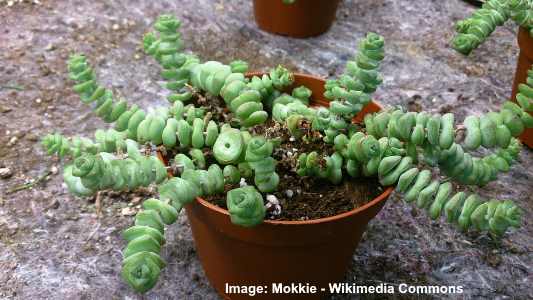
The Jade ‘Necklace’ (Crassula marnieriana) is a hybrid of jade plants from the genera Crassula perfoliata and Crassula rupestris. This plant features thin leaves with triangular chubby succulent leaves, similar to the ‘Silver Springtime’ jade cultivar. This succulent has a necklace-like appearance due to the jade-green leaves, which are somewhat smaller than other jade plants. Beautiful clusters of white starry blooms appear at the end of the stems each winter.
Crassula Sericea ‘Hottentotta’

The ‘Hottentotta’ dwarf cultivar of the genus Crassula is another of the unusual species of jade plants. This little succulent plant resembles lithops succulents more than jade trees. Little thin stems grow in columns and are surrounded by plump fuzzy leaves.
This dwarf jade won’t grow taller than 6″ (15 cm) unless you treat it right. The blooms of the hottentotta produce clusters of little blooms on an inflatorescence, which is an extended flowerhead.
Blush Plakkie (Crassula Cultrata)

The Blush Plakkie is from the jade species Cultrata, and it has light green extended leaves. The reddish stems and bright green long, tear-shaped leaves distinguish this jade cultivar. On the margins of many of the succulent leaves, you’ll also notice reddish-brown blushing.
This little jade tree, which resembles a shrub rather than the classic tree shape, grows only to around 32″ tall (80 cm). Little yellowish blooms sprout from the ends of the branches when it blooms, forming loose clusters. They may reach a length of up to 1 foot (30 cm).
Wooly Crassula (Crassula Tomentosa)

The Wooly Crassula variety of jade plant is one of the most unusual, with tiny hairs on its rosette-shaped leaves. These leaves develop in a rosette form, as do the leaves on most jade trees. The majority of the leaves are green, although there are occasional crimson-colored ones. The tiny hairs that cover the leaves give this plant its name, which is a wooly jade. This succulent houseplant may grow to be 2 feet (60 cm) tall when mature and blooming.
Red Jade Plant (Crassula Coccinea)

The species Crassula coccinea is the best option if you want a jade plant with crimson flowers that is miniature in size. The triangular leaves of this tiny succulent plant create cone-like stems. Only 16 inches (40 cm) tall is the Jade Shrub. This species blooms throughout the summer, unlike other flowering jade plants. The jade-colored stems, which appear to be an explosion of bright colors, are capped by brilliant red flowers.
How to Care for Jade Plants
At home, jade plants are some of the simplest to care for. You don’t have to be “lucky” to take care of them properly, despite their reputation as a lucky charm and wealth predictor. Not watering jade plants excessively is the most important care tip. Wait until the top 2 inches (5 cm) of soil is dry.
Wait until all the water is gone from the bottom of the pot before watering. Before repeating the process, wait until the soil has dried out again. This may happen every 1 to 2 weeks in hot summers. A jade plant only needs to be watered very seldom in the winter.
Keep your jade plant out of the direct rays of the sun is another piece of advice to follow. Place it in a sunny area of your home and maintain temperatures between 60°F and 75°F (15°C and 24°C). Pruning your jade money tree will help to keep it under control and give it a nice form. In the springtime when it has begun to grow again, you may trim back up to one-third of the stems. Leggy, drooping, or overgrowing stems should be pruned off. Your jade plant will thrive and produce thick dense foliage as a result of this.
